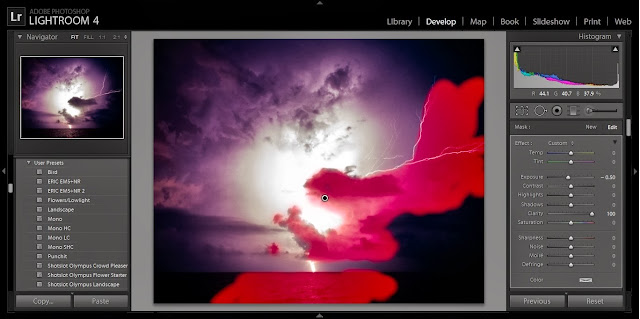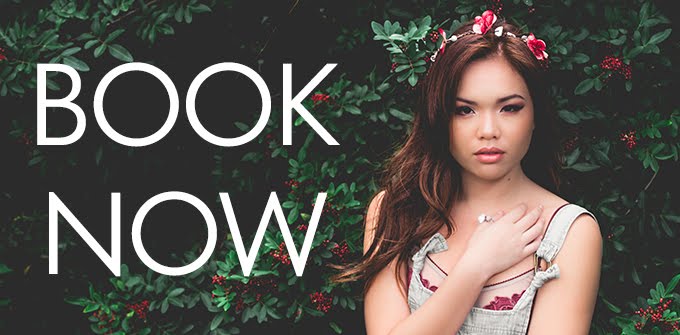Yesterday I was reading about this absolutely amazing photograph of
lighting taken at the Grand Canyon and thought to myself how awesome and challenging it would be to try and capture this subject. It is funny how things work... problems on the ship I am on lead to my night shift being cut short and when I left, there was a show waiting for me outside.
 |
| Love and lightning, 15mm, f/8, 0.4 sec, iso 1250 |
There are several problems with this photo and it does not even come close to the awesomeness of the Grand Canyon shot, but being inspired by Rolf Maeder I thought I would share my post processing workflow for this image. When I took this photo I was using "live bulb" mode on my EM5 and out of sheer luck had pushed (and held down) the shutter button right as this bolt struck. Since lightening is VERY bright, keeping my shutter open for so long (a little under half a second) greatly overexposed my image.
 |
| RAW |
I did not think that I was going to be able to use this image at all, but I figured I would give post processing a shot. Luckily you take in a lot of image "data" if you shoot RAW and I was able to recover a surpirsing amount of detail using Lightroom 4 (LR4). My first two steps were to use the "auto tone" and "auto white balance" functions. For auto tone, LR4 uses the information about the lightness or darkness of the the photo and tries to "normalize" it's exposure. If you look at the top right corner of these screen grabs you notice a "
Histogram" module. Putting it
very simply, it shows the distribution of lightness v.s darkness (or tonal range) in your photograph. In the raw screengrab above you can see that the distribution of the histogram is skewed to the right.. this means that a majority of the pixels in the image were "light" in nature. Auto tone works to correct this and the results are reflected in the image and histogram below. [On a side note... exposure is something that should be accounted for while taking an image to maximize the detail in your photo and the "auto tone" function should not be relied on. I did not anticipate the bolt was going to be so bright and should have had an increased shutter speed. While using auto tone was not optimal, it was my the best best solution to try and recover this photo.] Auto white balance adjusted the warmth of the image so it was less blue (cold) and more purple/pink.
 |
| Corrected tone and white balance |
Next, I adjusted the contrast, highlights, shadows, whites, blacks, clarity, and vibrance sliders to increase the dynamic range of this photo. This is a touchy subject among photographers, and one side of the playing field believes a photo should endure minimal post processing to keep the photo in its most "natural" state. But I think that a photo should grab the viewers attention and I am usually one to try to increase the "pop" of a photo.
 |
| Increased dynamic range.. or "made it pop" |
The combination of the lens I used (15mm Olympus body cap lens) and bright light caused pretty significant
vignetting which was slightly increased on the left hand side of this photo. To alleviate the unevenness, I used LR4's crop function (8x10) to even this out. I did not bother trying to remove the vignette because I liked the overall effect it gave. I also tried to line up the horizon so that overall, the waterline was symmetrical on either side of the photo.
 |
| Cropped |
From the picture above, you can see that the water line is bowed in or not straight along the gridlines provided by LR4. This is because of
optical distortion which is common with wide lenses. In order to alleviate this I used LR4's lens correction module to level out the waterline.
 |
| Corrected optical distortion |
Because I corrected the optical distortion, I needed to go back and re-crop the photo so that none of the edges were bowed in. I couldn't tell the water line was uneven until I cropped it the first time, or I would have corrected for distortion first.
 |
| Second crop |
Next, I used the noise reduction and sharpening tools to try to maximize the details. I think the Olympus body cap lens is great, BUT it renders the worst image quality out of practically anything you can put in front of the EM5. There is not much you can do about this and I love this lens for other reasons besides its image quality. I need to invest in a more robust "wide angle" lens for my EM5, but for now the body cap lens is doing a fine job of capturing some great images for me.
 |
| Sharpened with noise reduction applied |
So now my image is at a state where I have altered it a bunch so I go back through and re-evaluate/alter my dynamic range sliders (contrast, shadows, clarity, vibrance etc..) until I am happy with the image
... Normally I would stop here in my editing process, BUT, I want something more. Now here is where things really get into that slippery "is this natural" area, but its my interpretation of reality I wanted this image to be BOLD. In order to accomplish this I used the adjustment brush to darken or "burn" the clouds in front of the lightning bolt in addition to the water that is being illuminated by it.
 |
| Burned to accentuate foreground |
Now the image foreground is where I want it to be so I go back and make my final adjustments to the "dynamic range" sliders until I am completely satisfied with it's coloration and "pop".
 |
| Final dynamic range adjustments |
Finally, I used
Huelight's color fidelity high contrast camera profile to give it even more of a boost in color. I love their profile for the EM5 and it can be purchased for a mere $10 if you click the link above. It comes in "standard", "low-contrast" and "high contrast" profiles. I usually apply this profile first as it alters my raw images in a way that mimics the out of camera jpeg provided by the EM5. This time around I forgot to apply it till the end but I think it gave the photo that final firm kick in the behind and made it shine.
 |
| Huelight "high contrast" camera profile applied |
Well, I hope this gave you insight into my post processing technique good or bad as it may be. I taught myself how to use LR4 through trial and error and I am sure there is plenty that I have yet to learn. Your opinions are always welcome here or on my Flickr page and I am wide open for suggestions. Thanks for stopping by and reading my blog!!
-Sam D
MORE PHOTOS!!!
 |
| Shish kabob, 15mm, f/8, 1/60, iso 6400 |
 |
| "Actually, lightning comes from the bottom up", 15mm, f/8, 1/60, iso 2500 |
 |
| Split second, 15mm, f/8, 1/60, iso 3200 |
 |
| After the Aftermath, 15mm, f/8, 1/60, iso 2500 |





















































.jpg)


































